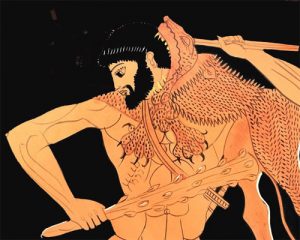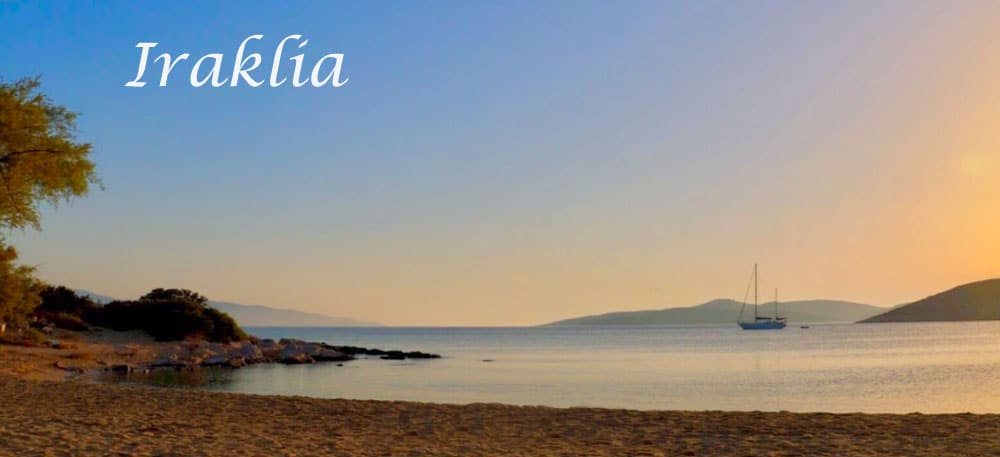Brief referencee to Iraklia’s History

The first human traces on Iraklia date back to the Proto-Cycladic period, around 3200-2000 BC. The Cycladic regions in Greece were known for their Minoan influences, and Heraklion was no exception. Later, during the Mycenaean period, the island was part of the Mycenaean civilization.
Iraklia has kept its name since ancient times. Stephen Byzantius and Pliny attest to this. However, the safest evidence for the existence of an ancient Iraklia is an inscription published in 1902 by Delamarre on the subject of a decree of the 3rd century BC. this decree states that the community of Heraklion forbade the importation and breeding of goats on their island, not because of any religious prohibition or sacred law but because of a civil case. Iraklia seems to have been continuously inhabited from prehistoric times to medieval times.
In the places Kampos Ag. Athanasios to the NW and Agios Mamas to the SE of the island there are traces of large prehistoric settlements in the latter place there was also an extensive proto-Cycladic cemetery, which however did not escape the action of antiquarians, who exhaustively explored it. In the above locations, spirals have been carved on flat rock surfaces with an impact technique, similar to those known from Naxos.
On the eastern side of the island, the ruins of the Hellenistic fortress, known from the time of Ross, are preserved at the Kastro site. Life continued throughout the Middle Ages and more recent times up to the last century, many remains of the later constructions are preserved in an area of 50 x 150 m.
In this area there are two statue bases, an olive press and sherds from the 5th – 4th BC were collected. century as well as some prehistoric shells. Iraklia seems to have prospered in the second phase of the Cycladic civilization [2800 – 2200 BC] as evidenced by various figurines, heads, marble bottles, clay spheres, compasses, tools [chisels, chisels] and other findings that, unfortunately, adorn foreign private collections or museumsr.
The Monastery of Chozoviotissα has owned and occupied the hermitage [Iraklia] since time immemorial, as can be seen in the sealed [patriarchal] document for the month of November of the year 1702 and from earlier Chrysovulas [Imperial documents]. Iraklia used to be the prefecture of the goats and sheep and other animals of the Monastery, which were grazed by two or three monks. The I. Monastery wanted to make Iraklia more profitable, in the year 1831 on February 1st it invited various farmers living in Aigiali Amorgos and agreed with them to go to Iraklia and clear part of the grazing lands in the Livadi, Agios Georgios, Panagia and Agios Athanasios by setting fire to small bushes and toasts.
They agreed to cultivate the land for a decade and after deducting expenses and legal taxes to give half of the net income to the Monastery. according to the agreement the farmers can have no more than ploughmen, one cow and one donkey on the island.
Medieval times Turkish rule
Life in Iraklia continued in the following centuries, but there were also periods when the island was deserted due to the activity of pirates, a fact that also happened on other Aegean islands (Amorgos, Ios, Astypalaia). Many argue that the island was uninhabited during the Turkish occupation. This opinion, however, is not correct, as there are written testimonies that Iraklia in the 16th century was an ecclesiastical member of the patriarchal Exarchate and in 1646 of the Archdiocese of Sifnos.
Modern times
Since 1928, Iraklia has been a separate community with a population of 286 inhabitants. It is worth noting the resistance reaction of the Iraklians during the German occupation. The coves of Voreini Spilia and Turkopigado were a refuge and base for Greek and allied commandos and saboteurs.
In 1942, a wireless was installed in the village of Panagia, in the house of Theodoros Gavalas, through which information was transmitted to the allied headquarters in Cairo. But most of the island’s youth also volunteered for the Allied army and fought against the Axis in El Alamein and in Italy, where they excelled in the Battle of Rimini
